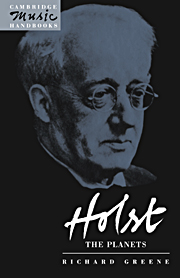Epilogue
Published online by Cambridge University Press: 21 November 2009
Summary
Outside of the chapter in Bernard Shore's Sixteen Symphonies and the one chapter in Imogen Holst's The Music of Gustav Holst, there was no detailed analytical work done concerning The Planets until the recent publication of Michael Short's book on the composer. Most studies of Holst's music in recent years have focused on vocal works such as The Hymn of Jesus and his late instrumental works, especially Egdon Heath and Hammersmith; yet popular interest in the suite has not diminished. There are nearly two dozen recordings currently available, and several historic performances, including Holst's acoustic recording from 1926, have now been released. The apparent lack of critical interest over the last sixty years needs to be explored in the face of the suite's popular success and influence.
Once the complexity of the language used in The Planets is understood, it becomes difficult to explain its appeal to the larger audience as being due to an assumed superficiality of content; yet such is the stigma of programmaticism that it diverts attention from the essential value of the work. In the case of Holst's suite, the intensity of character in each movement frequently overwhelmed the reviewers' larger critical awareness, so that descriptions of the composition were nearly always steeped in metaphor and melopoietic allusion, with little technical or theoretical discussion. It was also this intensity which must have swept up the general audience – who were, perhaps, totally unaware of the various musical, literary, pictorial, mythological, and even astrological references bandied about by critics – for no other classical music would have had for them the combination of power, novelty, and clarity of image displayed by the individual movements.
- Type
- Chapter
- Information
- Holst: The Planets , pp. 83 - 85Publisher: Cambridge University PressPrint publication year: 1995
- 2
- Cited by

